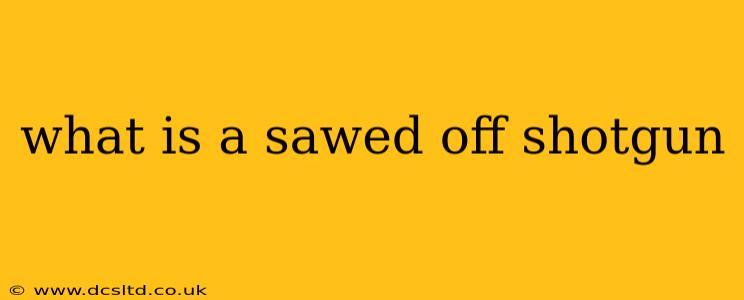A sawed-off shotgun is a shotgun that has had its barrel and/or stock (butt) shortened significantly from its original factory specifications. This modification dramatically alters the weapon's characteristics, making it more compact and concealable but also significantly impacting its accuracy and legal status. Understanding the specifics of sawed-off shotguns is crucial for both safety and legal compliance.
Why are Shotguns Sawed Off?
The primary reason for modifying a shotgun in this manner is to increase its concealability. A shortened barrel and stock allow the weapon to be more easily hidden in clothing or a vehicle. This makes it attractive to criminals who want a weapon that's readily available and easily concealed during illegal activities. However, it's important to note that this increased concealability comes at a significant cost in terms of accuracy and overall functionality.
What are the Legal Implications of Owning a Sawed-Off Shotgun?
The legal ramifications of possessing a sawed-off shotgun are severe in most jurisdictions. Federal and state laws in many countries strictly regulate, and often outright prohibit, the ownership of short-barreled shotguns (SBS) and short-barreled rifles (SBR). These laws generally define minimum barrel lengths for shotguns and rifles, and any modification below these legal limits is considered illegal. Penalties for possessing an illegal sawed-off shotgun are typically substantial, including significant fines and imprisonment. The exact specifics vary widely depending on location and local laws, so understanding the regulations in your specific area is crucial.
What are the Differences Between a Regular Shotgun and a Sawed-Off Shotgun?
The main differences lie in size, weight, accuracy, and recoil.
-
Size and Weight: Sawed-off shotguns are significantly smaller and lighter, making them easily concealable but also more difficult to control.
-
Accuracy: Shortening the barrel reduces the accuracy of the weapon dramatically. The shorter barrel decreases the time the shot has to stabilize, leading to a much wider spread of pellets and reduced effective range.
-
Recoil: The shorter barrel increases the felt recoil. The same amount of propellant pushing a smaller weight results in a sharper, more powerful kickback. This can make the weapon difficult to control and even dangerous to fire.
How Does a Sawed-Off Shotgun Work?
A sawed-off shotgun functions fundamentally the same as a standard shotgun. It uses shotgun shells containing numerous pellets or slugs that are propelled from the barrel by gunpowder. However, the reduced barrel length significantly impacts its ballistic properties, as mentioned earlier, affecting range, accuracy, and recoil.
Is it Safe to Fire a Sawed-Off Shotgun?
Firing a sawed-off shotgun is significantly more dangerous than firing a standard shotgun. The increased recoil makes it difficult to control, increasing the risk of injury to the shooter or bystanders. The shorter barrel also concentrates the blast pressure, increasing the potential for burns or damage to the shooter's face and hands. Additionally, the reduced accuracy greatly increases the risk of unintended shots hitting unintended targets. It's crucial to remember that safety precautions are paramount, but the inherent dangers of these weapons make them extremely risky.
Can I Legally Own a Sawed-Off Shotgun?
In almost all instances, no. The overwhelming majority of jurisdictions have strict regulations against the possession of sawed-off shotguns. The only exceptions are typically limited to specific circumstances such as law enforcement or with proper licensing and registration under very specific and stringent conditions. It's absolutely essential to thoroughly research your local and national laws regarding firearms before considering the ownership of any type of firearm, including sawed-off shotguns.
Conclusion
Sawed-off shotguns represent a significant safety and legal hazard. Their modification reduces accuracy, increases recoil, and enhances concealability, making them attractive to criminals but exceptionally dangerous for all. Understanding the legal repercussions and inherent risks associated with these weapons is vital for responsible gun ownership and public safety. Always comply with all applicable laws and regulations.
